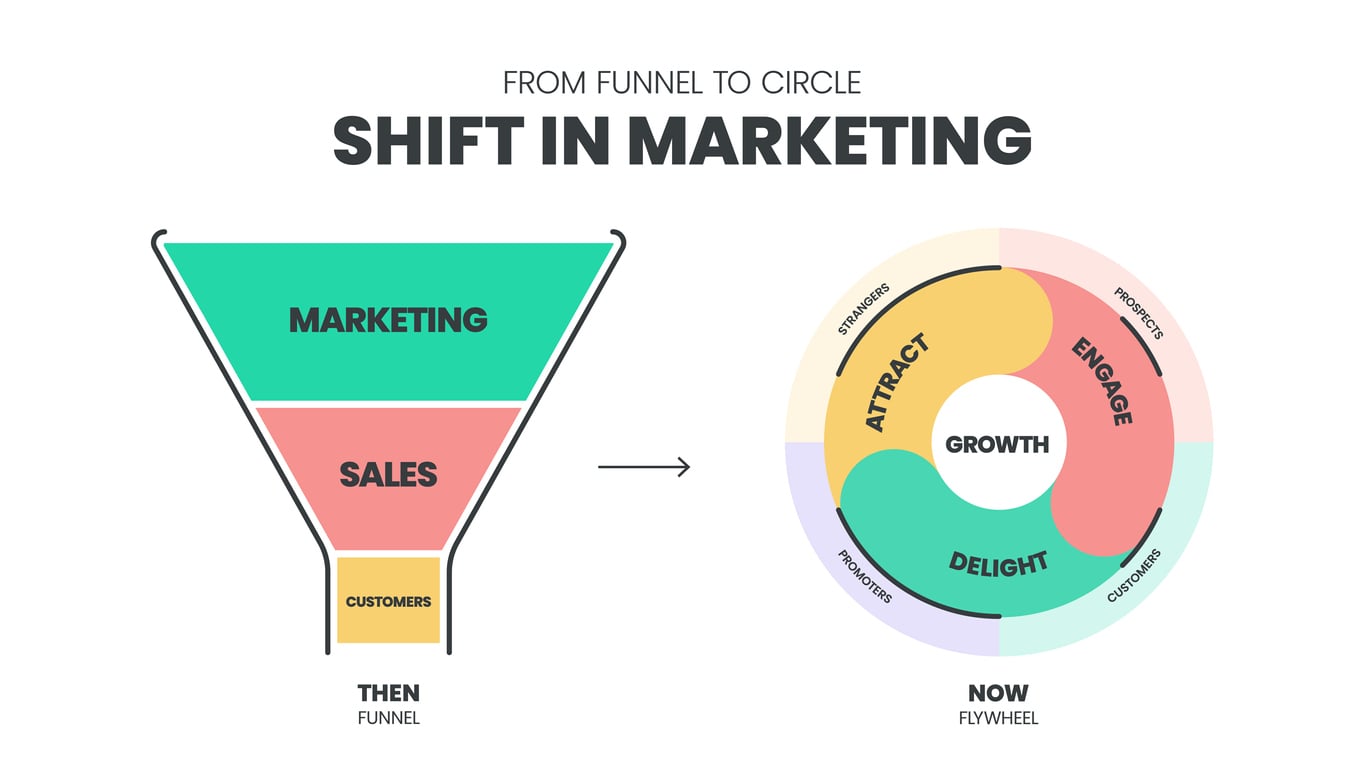In the evolving landscape of marketing, the traditional sales funnel is being replaced by a more dynamic and customer-centric model known as the flywheel. This article will explore the concept of flywheel marketing, its benefits, provide concrete examples, and outline the steps to implement it successfully.
What is Flywheel Marketing?
Flywheel marketing is an inbound marketing strategy that places customers at the center of your marketing efforts. Unlike the traditional sales funnel, which views the customer journey as a linear process ending with a purchase, the flywheel model emphasizes continuous engagement and customer satisfaction. The momentum generated by happy customers drives business growth through referrals and repeat sales[1].
Key Components of the Flywheel Model:
- Attract: Draw in potential customers with engaging and valuable content.
- Engage: Build relationships and trust with leads through meaningful interactions.
- Delight: Exceed customer expectations to create loyal advocates who promote your brand.
Why is Flywheel Marketing Important?
Flywheel marketing is essential for several reasons:
- Customer-Centric Approach: By focusing on customer satisfaction and engagement, businesses can build stronger relationships and foster loyalty[2].
- Sustainable Growth: The continuous cycle of attracting, engaging, and delighting customers creates a self-sustaining growth model[3].
- Efficiency: The flywheel model reduces the cost of customer acquisition by leveraging the momentum of satisfied customers to drive referrals[4].
- Adaptability: The flywheel can easily adapt to changes in customer behavior and market trends, ensuring long-term relevance[5].
Concrete Examples of Flywheel Marketing
Here are some real-world examples of how flywheel marketing can be applied:
Example 1: Amazon
- Attract: Amazon attracts customers with a vast selection of products and competitive pricing.
- Engage: The platform engages users with personalized recommendations based on browsing and purchase history.
- Delight: Amazon delights customers with benefits like fast shipping, easy returns, and excellent customer service, creating loyal advocates[6].
Example 2: HubSpot
- Attract: HubSpot attracts leads through valuable content such as blogs, webinars, and inbound marketing courses.
- Engage: The company engages users with personalized support and a comprehensive knowledge base.
- Delight: HubSpot delights customers with exceptional onboarding, dedicated account managers, and continuous product improvements[7].
Example 3: Shake Shack
- Attract: Shake Shack attracts customers with mouth-watering images and engaging social media content.
- Engage: The restaurant engages with its community by responding to customer feedback and creating a seamless dining experience.
- Delight: Shake Shack delights customers with high-quality food, personalized service, and exclusive deals[8].
Steps to Implement Flywheel Marketing
Implementing flywheel marketing involves several key steps:
- Define Your Ideal Customer:
- Clearly define your target audience and understand their needs, preferences, and pain points[9].
- Map the Customer Journey:
- Map out the entire customer journey from awareness to advocacy. Identify key touchpoints and opportunities to engage and delight customers[10].
- Align Teams and Processes:
- Ensure that marketing, sales, and customer service teams are aligned and working towards common goals. This collaboration is crucial for a seamless customer experience.
- Optimize Your Content Strategy:
- Create and distribute valuable content that attracts, engages, and delights your target audience. Use data and analytics to refine your content strategy continuously.
- Leverage Technology and Automation:
- Utilize marketing automation tools to streamline processes and ensure consistent engagement with customers. This includes email marketing, CRM systems, and social media management tools.
- Measure and Optimize:
- Continuously monitor the performance of your flywheel marketing efforts. Use analytics to measure key metrics and make data-driven adjustments to optimize your strategy.
Conclusion
Flywheel marketing is a powerful model that emphasizes continuous customer engagement and satisfaction. By following the steps outlined above and leveraging concrete examples, businesses can create a self-sustaining growth model that drives long-term success.
How TwiLead Platform Can Help
TwiLead is an all-in-one sales and marketing automation platform designed to enhance your flywheel marketing efforts. With TwiLead, you can:
- Automate Customer Engagement: Use TwiLead’s tools to automate customer interactions, ensuring consistent engagement at every stage of the flywheel.
- Personalize Content: Deliver personalized content at scale with TwiLead’s marketing automation features, ensuring that your messaging resonates with each customer.
- Track Performance: Monitor the success of your flywheel marketing efforts with TwiLead’s comprehensive reporting and analytics tools.
- Optimize Strategies: Use TwiLead’s advanced features to optimize your marketing strategies based on data-driven insights, driving higher engagement and conversion rates.
- Collaborate Seamlessly: Ensure seamless collaboration between marketing, sales, and customer service teams with TwiLead’s unified CRM platform.
By leveraging TwiLead’s robust features, businesses can streamline their flywheel marketing processes, save time, and drive more revenue. Whether you’re looking to attract new customers, engage leads, or delight existing customers, TwiLead provides the tools and support needed to succeed in today’s competitive market.
References
[1] Flywheel Marketing: What Is It and Why Should I Use It? – WebFX
[2] The Marketing Flywheel Model for 2025: Grow Faster With Your Customers
[3] What is Flywheel Marketing? – Frescodata
[4] How Flywheel Marketing is Transforming Customer Engagement – Llama Lead Gen
[5] What is Flywheel Marketing Model – Concept And Examples – The Brand Hopper
[6] Marketing Flywheel – The Strategy Story
[7] Flywheel Marketing: A Complete & Actionable Guide – Brafton
[8] The Flywheel Model – HubSpot
[9] Quick-start guide to effective flywheel marketing – Contentoo



